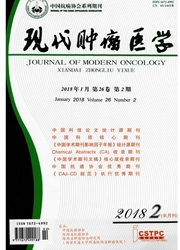

 中文摘要:
中文摘要:
目的:探讨乳腺浸润性微乳头状癌(IMPC)的临床病理特征、诊断、鉴别诊断及预后.方法:回顾性分析7例乳腺IMPC患者的临床表现、组织病理特点、免疫组化结果,同时进行文献复习.结果:7例乳腺IM-PC患者无特殊临床症状和体征.组织病理特点:IMPC肿瘤细胞团排列形成不含纤维血管轴心的微小乳头状或假腺管状结构,其外侧缘呈锯齿或毛刺状;每个肿瘤细胞团与周边的间质之间存在大小不等的腔隙,其内缺乏内容物.免疫组化染色EMA阳性部位在癌细胞巢团的外缘.结论:乳腺IMPC是一种特殊类型的乳腺浸润性癌,比较少见,但因其具有高淋巴血管侵犯、高淋巴结转移等恶性生物学行为,预后较差,应引起病理及临床医生的足够重视.
 英文摘要:
英文摘要:
Objective: To investigate the clinicopathological characteristics, diagnosis, differential diagnosis and prognosis of invasive micropapillary carcinoma (IMPC) of the breast. Methods: The clinical manifestations, his- topathological features and immunohistochemical results of 7 patients diagnosed with breast IMPC were analyzed retro- spectively, along with a review of the related literatures. Results : Seven cases of breast IMPC patients had no specific clinical symptoms and signs. Histopathologically, tumor cell clusters were arranged in micropapillary or pseudoglandu- lar structures without any definitive fibrovascular cores, which had serrated or ragged peripheral borders. The cell clus- ters were separated from the surrounding stroma by apparent clear spaces without an endothelial lining. Immunohisto- chemical studies were carried out to see the characteristic pattern of EMA expression. It typically stained peripheral cells of the tumor cell clusters. Conclusion: IMPC is a relatively rare, special type of invasive breast carcinoma. The pathologists and clinicians should pay more attention to this disease with its malignant biologic behaviors such as high lymphatic vessel invasion,lymph node metastasis and poor prognosis.
 同期刊论文项目
同期刊论文项目
 同项目期刊论文
同项目期刊论文
 Ensemble classifier based on context specific miRNA regulation modules: a new method for cancer outc
Ensemble classifier based on context specific miRNA regulation modules: a new method for cancer outc Construction and investigation of breast cancer specific ceRNA network based on the mRNA and miRNA e
Construction and investigation of breast cancer specific ceRNA network based on the mRNA and miRNA e Characterizing dynamic regulatory programs in mouse lung development and their association with tumo
Characterizing dynamic regulatory programs in mouse lung development and their association with tumo 期刊信息
期刊信息
